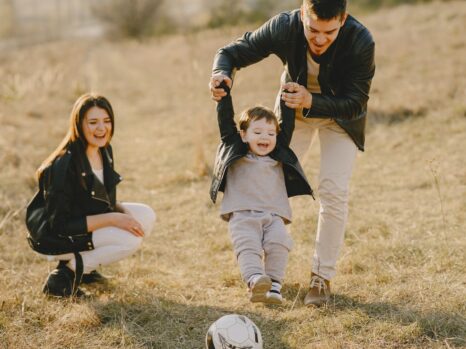From a very young age, children start developing habits, manners, and behaviors. During the first few years of their life, their social circle mainly includes close relatives and parents, and they learn early behaviors by imitating them.
As children grow older, their social circle expands to include friends, teachers, and other adults who may intentionally or unintentionally encourage certain behaviors while discouraging others, ultimately shaping specific behavioral patterns.
As adults, it is our responsibility to recognize negative habits and behaviors in children and take appropriate measures to modify them into acceptable behaviors.
Although most adults have an inherent instinct to correct misbehaviors in children, many of their actions lack structure and consistency, ultimately failing to achieve the desired results. This failure often leads to frustration and negative feelings such as anger and self-doubt.
Therefore, it is crucial to understand behavior modification techniques and their various benefits to design an effective method that caters to the needs of the child.
Understanding What Is Behavior Modification Techniques
Behavior modification is a technique for transforming harmful habits and behaviors into positive and healthy actions through the use of rewards and consequences.
In psychology, behavior modification is based on the idea that our surroundings shape or condition us. This means that our actions and reactions are influenced by the positive outcomes and incentives that are associated with our behavior.
By altering the environment and making consequences into punishments, we can be motivated to change our behavior. This approach is focused solely on modifying behavior rather than exploring its root cause.
Behavior modification was first tested on animals in the late 1800s. Researchers observed that animals responded to training that utilized food rewards. Initially, behavior modification was not widely accepted and encountered much resistance until the mid-1900s.
However, through the extensive work of psychologists such as Jerzy Konorski and B.F. Skinner, behavior modification was finally recognized as a legitimate psychological treatment in 1950. Since then, numerous behavior modification strategies have been utilized to treat various diseases.
Techniques of Behavior Modification
Experts in psychology have created a variety of behavior modification techniques to address a range of problems. The following methods are commonly used for modifying the behavior of children and are briefly explained below, with relevant examples to assist parents and teachers in choosing the most appropriate approach.
Positive Reinforcement
The method of positive reinforcement involves providing children with rewards in order to encourage desired behavior. Receiving a gift can create positive emotions like excitement and joy, making it an effective technique for behavior modification in children.
To avoid monotony, it is recommended to surprise children with a variety of rewards, which could include their favorite foods, objects, additional playtime, verbal praise, surprise outings, or extra TV time.
For example:
Giving a child additional time to engage in their preferred activity
- Allowing a child to play their favorite video game if they complete their homework on time
- Extending a child’s playtime as a reward if they exhibit good behavior in class.
Negative Reinforcement
The Escape/Avoidance technique of behavior modification involves motivating children to adopt desired behavior to avoid unpleasant experiences caused by parents, teachers, or therapists.
Here is an example to explain this method:
Children may behave as instructed to escape from the constant nagging of their parents.
- Your daughter may clean her room regularly to avoid being scolded by you.
- Teachers can ask more questions to students who misbehave in class. To avoid the spotlight, the student may become attentive and refrain from disrupting the class.
Positive Punishment
The Positive Punishment technique of behavior modification involves assigning unpleasant tasks to children when they exhibit negative behavior. The aim is to discourage undesirable behavior by imposing negative consequences.
Here are a few examples:
- Allowing your son to suffer the natural consequences of missing the school bus due to oversleeping, without providing alternative transportation for him to attend the school trip.
- Refraining from helping a student who intentionally skips classes to catch up on missed notes. Instead, allow them to experience the negative consequence of low test scores.
Negative Punishment
The Negative Punishment technique of behavior modification involves taking away something that children enjoy as a form of punishment for negative behavior. By removing privileges, such as favorite foods or playtime, children are motivated to correct their behavior to regain these benefits.
Here are a few examples:
- If your child throws tantrums whenever they lose against other children, you can impose a ban on playing for a few days as a punishment.
- If a student misbehaves during class hours, you can make them sit on the bench during their playtime hours as a negative consequence.
Other Child Behavior Modification Techniques
To end a child’s misbehavior, it is important to use one or more of the four main behavior modification techniques. However, there are other techniques that can be helpful, such as:
- Reward charts.
- Token economy.
- Behavior contracts.
- Elimination.
Reward charts and token economies
These allow children to earn stickers, stamps, or small tokens that can be turned into rewards or privileges. This is an example of positive reinforcement. Certain families may offer rewards such as movie nights, game nights, special dinners, or other incentives that hold significance to their children.
Behavior contracts
These work well with kids in mid- to upper elementary school and middle school. Kids are empowered and more willing to cooperate because they have input into their responsibilities and rules. It is crucial for parents to fulfill their obligations outlined in the agreement by carrying out the reinforcements.
Elimination
With this technique, parents don’t react to their child’s misbehavior. Instead, they deny them the attention and permission they seek. When kids discover that parents won’t back down and will simply ignore their behavior, they eventually stop doing what parents don’t like. This eliminates their behavior.
How to Set Up Behavior Modification Plan Step by Step?
Here are some steps you can follow to create a behavior modification plan for your child.
- Try to Understand your Child
Considering your child’s age, gender, preferences, and other relevant factors is crucial to determine their receptiveness to various behavior modification approaches. For instance, while spending more time with a parent might be considered a reward for young children, it could be perceived as a punishment for teenagers since it reduces their time with friends.
- Understanding the Behavior to Modify
Take into account the effort and time needed to modify the behavior. For instance, teaching a child not to waste food may require positive reinforcement, but preventing bedwetting at night may necessitate more time and the use of multiple techniques.
- Choose the Method That Works Best for Your Child
Positive reinforcement techniques are often effective for younger children, while a blend of negative and positive punishments may be more suitable for teenagers. It’s important to be flexible and willing to modify or develop new approaches when current methods prove ineffective.
- Create a Behavior Modification Plan for Your Child
Develop a comprehensive behavior modification plan that includes rewards, consequences, and punishments tailored to the specific behavior you want to correct in your child.
When there are natural consequences for negative behavior, consider if the child has had enough for the day and whether or not they should face additional consequences.
It’s important to find the right balance in your approach to ensure that you don’t push your child too hard or not enough, as either extreme can render a technique ineffective.
Benefits of Behavior Modification Techniques
Our life can be significantly impacted by even the smallest alterations in our behavior. Behavior modification therapy offers numerous benefits, including:
- Overcoming various disorders, such as Obsessive-Compulsive Disorder (OCD), Post-Traumatic Stress Disorder (PTSD), substance abuse, and addictions, thereby boosting confidence and enhancing the quality of life.
- Resolving physical and mental health issues, such as eating disorders, chronic pain, insomnia, depression, phobias, and others, thereby improving overall well-being.
- Equipping individuals with the necessary tools to manage and alter problematic behaviors, which can enhance both personal and professional relationships, as well as teach coping mechanisms for handling unexpected challenges in life.
- Boosting employee motivation by offering attractive incentives.
- Providing parents and teachers with successful techniques for addressing behavior disorders in children.
- Being an economical short-term treatment, ranging from several weeks to months depending on the issue.
- Offering straightforward and easily learned techniques for positive lifestyle changes.
Tips for Child Behavior Modification
Children’s behavior can be challenging to manage at times. As a parent or caregiver, it’s essential to understand that children’s behavior is a form of communication. Sometimes, they may act out when they’re feeling overwhelmed, frustrated, or just seeking attention.
It’s up to the adult to identify the reasons behind their behavior and use behavior modification techniques to help them learn better ways of expressing themselves. Here are some tips for child behavior modification.
Be Consistent: Consistency is key when it comes to behavior modification. Children need to know what is expected of them and what will happen if they don’t meet those expectations. Consistency helps them understand that their behavior has consequences.
Set Clear Boundaries: Children thrive in environments where they know what’s expected of them. Setting clear boundaries and expectations helps children understand what behaviors are acceptable and what are not. Make sure that you explain the consequences of breaking the rules, so they know what will happen if they don’t follow the guidelines.
Use Positive Reinforcement: Positive reinforcement is an effective behavior modification technique. Praise your child for good behavior, even if it’s something small. This reinforces the idea that good behavior is desirable and encourages them to continue with it.
Avoid Negative Reinforcement: Negative reinforcement is using punishment or taking away privileges to change behavior. While it can be effective in the short term, it doesn’t teach children how to behave better. It’s better to focus on positive reinforcement and teaching them alternative ways to behave.
Offer Choices: Giving children choices can help them feel more in control of their behavior. It’s important to provide them with acceptable options, so they still meet the desired outcome. For example, instead of saying, “Clean up your room,” you could say, “Would you like to pick up your toys first, or make your bed?”
Use Time-Outs: Time-outs can be an effective way to manage behavior. When a child is misbehaving, removing them from the situation can help them calm down and think about their behavior. Make sure that time-outs are not used as punishment, but rather a chance for them to regain control of their behavior.
Model Appropriate Behavior: Children learn by example. Make sure that you’re modeling the behavior you want to see in your child. If you’re consistently displaying positive behaviors, they’re more likely to follow suit.
Managing children’s behavior can be challenging, but it’s essential to use effective behavior modification techniques to help them learn better ways of expressing themselves.
Consistency, clear boundaries, positive reinforcement, avoiding negative reinforcement, offering choices, time-outs, and modeling appropriate behavior are all effective ways to manage children’s behavior.
Final Words
Behavior modification techniques are effective in various situations, including child behavior. Positive and negative reinforcements, as well as positive and negative punishments, can be used to modify behavior.
Parents can create a behavior modification plan to teach their children good habits and behavior, while teachers can use behavior modification techniques to improve classroom control.
By utilizing the tips in this article regarding behavior modification and implementing positive and negative reinforcers, punishments, and consequences, children and students can learn and repeat desired behaviors. It’s important to create a plan and stick to it, as this can lead to noticeable improvements almost immediately.














